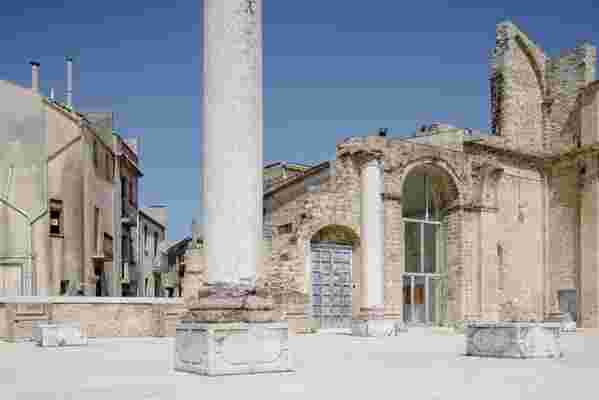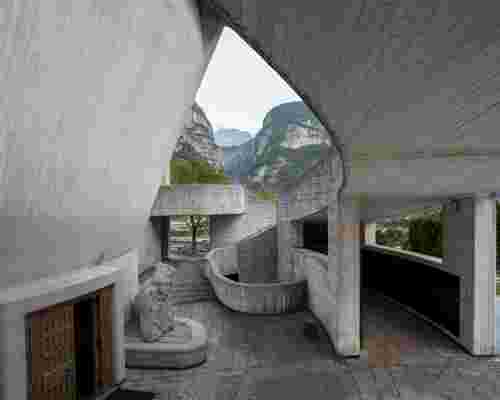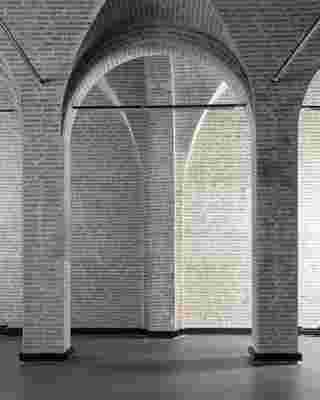
Roberto Boccaccino, Piazza Alicia and adjacent streets, Salemi, TP, Roberto Collovà, Alvaro Siza 1982-1998, 2019
Italy is studded with historical buildings of incomparable value, and the same applies to its contemporary heritage. Photographically documenting this surprising variety of styles and languages is certainly not easy: an up-to-date “Italian journey” would have the task of confronting contemporaneity and stimulating discussion of remembering. Triennale Milano is now filling this gap with the exhibition “10 Journeys in Italian Architecture” (through November 7) in the spaces of the Milan institution, produced in collaboration with the General Directorate for Contemporary Creativity (DGCC) of the Ministry of Culture and the Museum of Contemporary Photography.

Marina Caneve Church of the Immaculate Conception of the Virgin Mary Longarone, BL Giovanni Michelucci 1966 -1978 2019
Curated by Matteo Balduzzi, Alessandra Cerroti, and Luciano Antonino Scuderi, the exhibition offers 110 images made by young photographers along 10 itineraries that cross the Italian peninsula and reveal the variety of its contemporary architectural heritage.
“Photography and architecture are once again proving to be perfectly complementary, capable as they are of interpreting and capturing light, form, and volume,” declared the Minister of Culture, Dario Franceschini. “The decision to entrust photographers under 40 with a specific commission for Atlante Architettura Contemporanea is also fully in line with the mission of the Ministry’s General Directorate for Contemporary Creativity to invest in new talent in order to enhance the present together with the great tradition of our past.”

Luca Girardini and Marco Zorzanello Museo Monumento al Deportato Carpi, MO BBPR Albe and Lica Steiner 1963 -1973 2020
Between 2019 and 2020 Roberto Boccaccino, Marina Caneve, Davide Cossu, Louis De Belle, Luca Girardini and Marco Zorzanello, Paolo Lindozzi, Allegra Martin, Simone Mizzotti, Flavia Rossi, and Alberto Sinigaglia have produced almost 3,000 photographs, images that will go to enrich the Atlante Architettura Contemporanea website, a platform created in 2018 by the DGCC with the ambitious idea of mapping and disseminating knowledge of Italian architecture from the second half of the 20th century to the present day.
Luca Girardini and Marco Zorzanello Le Fontanelle residential unit San Martino di Castrozza, TN Bruno Morassutti, Andrew Powers 1963 -1966 2020
“Architecture and photography are two closely related disciplines.” adds Stefano Boeri, president of Triennale Milano. “Photography has the ability and power to tell the story of architecture, focusing as much on the detail as on the overall view, on the relationship and dialogue between a building, the pre-existing structure, and the surrounding environment, as well as on the ways in which the people who live in that building every day use it.”
Thanks to a scenographic setup conceived by Studio Folder of Milan, the exhibition brings together 110 medium- and large-format prints on a relief map of the Italian peninsula that allows visitors to relive the itineraries traced by the photographers along the Italian territory (there are 250 structures documented thanks to the project).
Allegra Martin Giomein residential complex Valtournenche, AO Mario Galvagni 1965 -1972 2019
The geographical and analytical reading suggested by the map thus dialogues with a large-format projection, a sort of backdrop in which the totality of the images is ordered in short sequences according to purely formal and compositional criteria.
Flavia Rossi Casa Lina Marmore, TR Mario Ridolfi 1964 -1967 2019
The catalogue, published by Silvana Editoriale, is also based on the travel guide and, in the very restricted selection of buildings and images, tends to enforce the homogeneity of the work. The visual narrative is enriched by critical contributions and annotations that the photographers produced during or after their campaigns. The personal travel diary is rich in observations, anecdotes, and suggestions, reflections that interact with the images and contribute to enhancing their informative value. These travel journals, although short, reveal the sensitivity and personality of each. Read as a whole, they constitute an aesthetic reflection on the practice of photography: From these lines emerges a common cognitive tension, a never-ending relationship with places and space, a reflection on the perception of time and light, on the sense of travel and the “photographic” pleasure of discovery.
Flavia Rossi, Expansion of the Municipal Cemetery. Jesi, AN. Leonardo Ricci, Franco Luminari, Silvano Rossini 1984-2001, 2019
At the end of the exhibition, all the shots will flow into the collections of the Museum of Contemporary Photography, thus enriching a public cultural heritage already of considerable value.
“With great professionalism, each photographer has agreed to put their creative experience at the service of a choral, ‘objective’ narrative, which in terms of coherence and breadth of design and fidelity of execution has its roots in 19th- and 20th-century public missions and constitutes an ideal continuation of them,” concludes Giovanna Calvenzi, president of the Museum of Contemporary Photography.
This story originally appeared in AD Italia .
